The long read: The great trick of online retail has been to get us to shop more and think less about how our purchases reach our homes
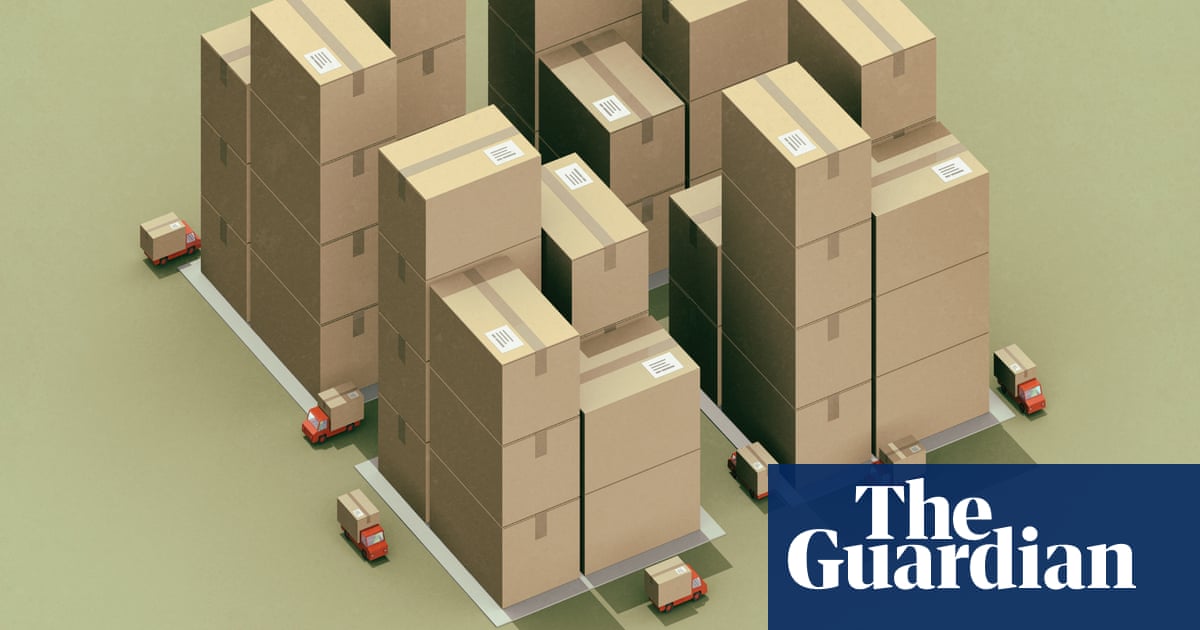
A decade ago, the British department-store chain John Lewis built itself a long warehouse, painted in gradations of sky blue. The shed, as it is called in the industry, cost 100m and covered 650,000 sq ft. Windsor Castle could easily fit inside it. John Lewis named the shed Magna Park 1, after the site where it stands: a logistics campus of warehouses, roads, shipping containers and truck bays east of Milton Keynes. Magna Park 1 was intended to supply the companys stores around southern England, but almost as soon as it was finished, John Lewis realised that it wasnt enough. The pace of e-commerce was flying, and Magna Park 1 opened in the midst of a spell in which, between 2006 and 2016, the share of John Lewis deliveries going direct to customers rose 12-fold.
So John Lewis built Magna Park 2, measuring 675,000 sq ft. After that, the company realised it needed a new shed for Waitrose, its supermarket chain, where home deliveries were skyrocketing, too. It became a bit of a standing joke, said Philip Stanway, a regional director at Chetwoods, the architecture firm that designed and built all these facilities. They used to come to meetings with their forecasts, and theyd say: Screw this. This is the new forecast, Stanway said, making a scribbling motion in the manner of a John Lewis executive hastily updating the numbers. We couldnt build the buildings quick enough for them.
The Waitrose shed ended up spanning close to 1m sq ft. And then, even as Magna Park 2 was being constructed, John Lewis decided to commission Magna Park 3 to fulfill more home deliveries. Magna Park 3 was slightly smaller than the others, Stanway said just 638,000 sq ft. But thats only because that was the size of the plot. That was all the land was left.
John Lewiss appetite for shed space is, at its heart, the story of the explosion of home delivery a story in which we have all been willing participants, since it is our clicking and swiping that has powered the boom. The e-commerce industry lives and dies by metrics, a few of which give us some grasp over this phenomenon. The sprawl of sheds like Magna Parks 1 to 3 are a particularly vivid measure, because they host the final moment of relative stasis for millions of products that are then sprayed out to homes in every direction. Amazons biggest fulfilment centre in the UK, in Tilbury, Essex, occupies 2m sq ft. (In comparison, Amazons first shed, leased in 1997, was 93,000 sq ft.) The volume of daily deliveries to homes has soared from fewer than 360,000 a day in New York City in 2009 to more than 1.5m today. In China, Meituans scooter drivers, in their banana-yellow helmets and jackets, delivered 30m food orders during a single weekend in July. There are numbers for distressing waste: the packaging of home-delivered products now accounts for 30% of the solid rubbish the US generates annually, and the cardboard alone costs 1bn trees. And there are numbers for frenzied growth: the $3.8tn (2.95tn) in global online sales in 2017 will near $6tn by 2024.
These statistics encompass a universe of products. You can summon groceries, alcohol and medicines to your home: chips and vodka on New Years Eve, say, and then aspirin on New Years Day. You can sign up for a Moss of the Month Club; that isnt code for weed, although you can get that delivered, too, in San Francisco or Denver. From the Northampton Reptile Centre, you can order a 20-pack of locusts to feed your tarantula. But most home deliveries consist of the familiar brown-cardboard parcels from retailers such as Amazon; in the US, Amazon is responsible for nearly half of all the 165bn packages delivered each year.
The great trick of online retail has been to get us to do more shopping while thinking less about it thinking less, in particular, about how our purchases reach our homes.This divorce of a product from its voyage to us is perhaps the thing that Amazon has sold us most successfully. Jeff Bezos, Amazons founder, never wanted his customers to worry about shipping about how much it cost, or about how long it would take and he relentlessly shredded delivery times to make shipping incidental to the purchasing experience.
Amazons emphasis on speed compelled other retailers to hurry, too, and encouraged us to believe that if something cannot be had quickly, it is barely worth having at all. It is as if we have forgotten that a product is an object moving through space, fighting gravity, air resistance and other forces of nature. Companies, though, are only too aware of it. While we choose and buy our purchases with mere inch-wide movements of our thumbs, they are busy rearranging the physical world so that our deliveries pelt towards us in ever-quicker time.
The frictionless appearance of a box on the doorstep is such a seductive notion. We have come to rely on it in such a brief period that we have not been able to grapple fully with the scale or the meaning of home delivery. For thousands of years, human progress was indexed to the ease and speed of our mobility: our capacity to walk on two legs, and then to ride on animals, sail on boats, chug across the land and fly through the air, all to procure for ourselves the food and materials we wanted. In barely two decades, that model has been turned inside out. Progress today consists of having our food and materials wing their way to each of us individually; it is indexed to our immobility.
The deliveries of e-commerce are radically different from those we knew earlier: milk, or newspapers, or pizza, brought home by businesses who did one thing and one thing only. Internet shopping invites you to gaze out upon the entire bazaar all at once and to indulge the merest whim. Perhaps online retails closest kinship is with the thick Sears catalogue sent out across the US early in the 20th century, listing more than 100,000 products: pianos, books, barbershop chairs. You could buy an entire house and have the parts shipped over in two railroad cars. Shipping was not free.
But the catalogues aim was to continually expand choice. E-commerces additional aim, and now its primary one, is to continually compress time. As far back as 1999, Bezos was captivated by the prospect of immediate gratification, and Amazon invested $60m in a company called Kozmo.com, which promised to deliver videos, games, DVDs, music, mags, books, food, basics & more to any New York City address in an hour or less. The company collapsed in 2001, but Bezos continued to muse on other models. He once suggested that, by paying college students on every Manhattan block to stockpile products in their apartments and to shuttle them up and down on bicycles, Amazon could edge towards near-instant delivery.
In 2005, Amazon created Prime: a club for shoppers paying a fixed fee every year, so that they got free two-day shipping on everything they bought. Prime now has more than 100 million members, and its rapid satisfaction acts like a drug. A market analysis firm, Consumer Intelligence Research Partners, found that 93% of Prime members keep their subscription after a year, and 98% after two years. Not for patient people, runs a Prime slogan, and it is right: one out of every three Prime members have chucked items out of their carts after learning that they could not arrive in two days. This summer, Amazon halved Prime shipping time down to a day; in October, Prime subscribers in the US became eligible for free two-hour grocery deliveries. When it was in development, Primes code name was Futurama, as if it was forecasting our experience of shipping-less shipping.
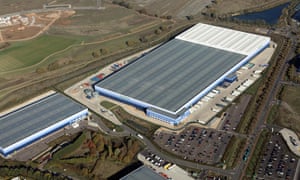
Implicit in this fixation with time is the thesis that the opportunity cost of regular shopping is too high that the hours spent driving to the better bookstore in the next town can be spent doing something more valuable. (Time is money. Save both, runs another Amazon Prime slogan.) But as our urban lives have grown more pressed for time, we have diced our opportunity costs finer and finer; from budgeting days or slabs of hours, we have come to rationing minutes. Delivery schedules have shrunk in parallel. You might now reason that even a 12-minute walk to the store to buy a can of beans is too great an expenditure of time, and that the fee paid for one-hour delivery is a fair price to snatch those minutes back into your life. Of course, the principle of opportunity cost assumes that we will earn the value of that fee back in some way in those 12 minutes whereas the truth is that we are most likely to squander them on Instagram. The internet promises us time, then takes it right back.
Beyond the fees we pay, our orders have costs some that we have recognised, and some that are slowly starting to come to light. A lot of attention has rightly been paid to the toll that fulfilling our orders takes upon workers in warehouses or drivers in delivery vans. But additionally, as our purchases hurtle towards us in ever-higher volumes and at ever-faster rates, they exert an unseen, transformative pressure on infrastructure, on cities, on the companies themselves. The customer is putting an enormous strain on the supply chain, said James Nicholls, a managing partner at Stephen George + Partners, an industrial architecture firm. Especially if you are ordering a thing in five different colours, trying them all on, and sending four of them back.
How the pressures of home delivery reorder the world can be understood best through the last mile which is not strictly a mile but the final leg that a parcel travels from, say, Magna Park 3 to a bedsit in Birmingham. The last mile obsesses the delivery industry. No one in the day-to-day hustle of e-commerce talks very seriously about the kind of trial-balloon gimmicks that claim to revolutionise the last mile: deliveries by drones and parachutes and autonomous vehicles, zeppelin warehouses, robots on sidewalks. Instead, the most pressing last-mile problems feel basic, low-concept, old-school. How best to pack a box. How to beat traffic. What to do when a delivery driver rings the doorbell and no one is home. What to do with the forests of used cardboard. In home delivery, the last mile has become the most expensive and difficult mile of all.
In Britain, back when the last mile referred only to a products transit from warehouse to shop, this journey began, most often, in the Midlands. This part of the country is a clearinghouse for millions of shipments every year. If you start at the John Lewis sheds near Milton Keynes, run up the M1 towards Nottingham, then dip back down past Birmingham, you have defined what the logistics industry calls the Golden Triangle. For at least 40 years, British firms have located their warehouses in the triangle because truckers setting out from here can reach close to 95% of the island inside four-and-a-half hours the longest they are allowed to drive without stopping for a break. Businesses are so wedded to the triangle that a pack of parmesan cheese might enter the country through the Felixstowe docks in Suffolk, travel up to a triangle shed for sorting, and then be sent right back to a Tesco in Felixstowe.
One afternoon, I went out to the triangle to Rugby, where I met Robin Woodbridge, a senior vice-president at Prologis, a real-estate company that builds and runs logistics parks. In this part of Warwickshire, the land rolls gently, so that, upon cresting a low rise or passing a copse of wind turbines, you suddenly spot a lot full of lorries or a complex of gigantic sheds. We all have a strange, secondhand familiarity with the warehouses and carrier facilities that exist in places such as this. We see their names or their locations when we thirstily track the progress of our orders, but it is only when a package stalls somewhere that we try to imagine what these sheds look like, how they work or why they might fail.
Woodbridge and I drove out to a Prologis estate called Dirft the Daventry International Rail Freight Terminal. When Woodbridge started out in real estate in 1991, the biggest sheds measured about 120,000 sq ft. A decade or so later, when Prologis built its first shed for Amazon, e-commerce hit and the warehouses started to tend towards enormous. Today, the biggest Dirft shed is a 1m sq ft facility for Sainsburys.
The warehouses that first occupied the triangle hosted shipments in transit from one business to another: B2B. They were built to move goods in bulk, so they stacked pallet upon pallet, rising in layers in a single, cathedral-like space. Time was not of the essence; a forklift could slowly bring down a pallet from on high and deposit it into a truck for transport. E-commerce sheds have called for altogether new levels of sophistication new ways to store stuff and to whisk it out at speed to customers. In these sheds, individual products rest on short racks, so they can be reached more easily by employees who pick and box orders. In order to fit more racks, companies put in several mezzanine levels. As a result, the sheds rise taller: 21 metres, compared to B2Bs 15 metres.
E-commerce has turned even the laying of a floor into a fiendishly involved business. The concrete floors of B2B sheds were already being built to an exacting degree of flatness, calibrated using lasers, so that forklifts would not teeter while lifting pallets to the highest shelves. As the urgency of home delivery grew, robotic pickers began to populate e-commerce sheds, so the floors had to be flatter still first poured to a standard called FM2, and the robots aisles then ground down further to FM1. In these superflat floors, even a 10th of a millimetre matters. The merest waywardness in a robotic picker can tangle up the whole sheds operations and delay thousands of deliveries.
But as delivery schedules have dwindled into hours, even the gigantic warehouse full of stuff in a central place such as the triangle is proving insufficient. Now, companies also need smaller distribution centres around the country, to respond rapidly to orders and to abbreviate the last mile as much as possible. These smaller sheds cannot stock as much, but the foresight of data analytics now makes a keen strategic efficiency possible. Woodbridge remembers how, while visiting a shipping providers facility a few years ago, he saw a curious pile of Amazon parcels.
I said: They havent got any names on them. Who are they for? he told me. The packages held video games, it turned out: the newest edition of the annual Fifa series by Electronic Arts. And they said: Amazon knows, if youve bought the game for the last three years or whatever, that youre likely to buy it again. So theyve already got it packaged up for you, waiting for you to press the button. You do that, and theyll stick your name on it, and its gone.
A video game may have spent weeks traversing half the world, from a factory in China to a shed on the outskirts of a British city. But its most dangerous hours lie in being rushed from a shed to a home a last-mile trip it must survive in the cheapest way possible. An average package is dropped 17 times before it reaches its purchaser. In a full truck, a box at the bottom bears the burden of the stack above it. When the truck is half-empty, packages slide about, slamming into each other when the van brakes, as it does often in cities. Its a smaller truck, its going over potholes, its going over all the things in your neighbourhood, said Kim Houchens, the director of Amazons customer packaging experience unit. Her tone was grim. She made it sound like a wonder that anything ever reaches us in one piece.
Houchens refers to the last miles tribulations as hazards, and her job is to engineer the cardboard box to withstand them. As a materials scientist, she knows plenty about harsh conditions. In the past, she worked for a Nasa contractor that designed spacesuits, and for another firm that developed military parachutes and ballistic vests for Operation Desert Storm. That is the calibre of person who, in the age of express delivery, is working on sciencing-up the plain cardboard box. Universities have packaging design labs now; at the Rutgers School of Engineering laboratory, they even test decoration adhesion, to see how well labels stick to the box. UPS and FedEx keep in-house researchers to study corrugated cardboard. Houchenss team has grown from seven members in 2014 to 85 today, and they work with more than 800 sizes and classes of boxes. For an artefact that lasts just minutes at its destination before proceeding to the recycling bin, the box is subject to an astonishing volume of thought.
In August, I went to see Houchens, who works out of a building next to a Lowes hardware store, on the outskirts of Seattle. This is where her team punishes Amazon boxes every day, to see how well they protect their contents. For my benefit, a man placed a packed, sealed box on a shoulder-height pedestal, in one or the other of 17 different ways: on its side, on an edge, upside down. When he pressed a pedal, the pedestal whipped away, and the box crashed to the floor. Elsewhere, a loud vibrating platform simulated a truck juddering through a city street. A box from a toy company was on the platform, with two barbell weights placed on top of it. The box was suffering; an edge had split and one side sagged. Nearby, a TV screen displayed an animated video of how boxes smack into each other as they tumble into a silo-like container. It looked like a mad, unwinnable version of Tetris.
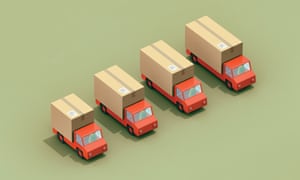
The cardboard box is the most potent symbol of the home-delivered world. It reminds us of the quandary of choosing between our consumption and the health of the planet. Even adding 1mm of thickness to the cardboard, to make it hardier, might use up a substantial forest when multiplied across hundreds of billions of boxes. A heavier box costs more to buy, and it also uses more fuel to ship. Like every company, Amazon has been trying to soften the impact of its last mile by designing boxes that are both light and strong. The company used to be notorious for excessive packaging, and social media grew littered with examples: three pairs of socks wrapped in puffy air bladders; hair ties wrapped in layers of cellophane; a small webcam box nestling inside a much larger carton. Houchens told me that Amazon has now shrunk the weight of its outbound packaging by 25% since 2016. In August, the company also announced that it would begin to levy fines on other vendors on its platform who over-package their products.
The environmental impact of all that paper and plastic is just one part of Amazons overall carbon footprint: equivalent to 44.4m tons of carbon dioxide, as the company revealed for the first time in September. That is less than Walmarts, but bigger than that of Apple, UPS or Denmark.The statistic doesnt really clarify whether home delivery is worse for the planet than a trip to the shop, though. In 2009, researchers at Heriot-Watt University in Edinburgh estimated that a shopper emits 24 times more carbon dioxide if she drives 12.8 miles to buy a single item than if she orders it online. Admittedly, in the world of last-mile logistics, 2009 feels like a lifetime ago a gentle era predating two-hour delivery or chronic try-and-return behaviour, which make an online shoppers carbon footprint bigger than that of a traditional shopper.
Besides, not everyone drives across town for one purchase; our patterns of buying are too numerous to be modelled wholesale. Many of us walk to shops nearby. Many more take public transport. For those of us in cities such as London, Paris or New York, it is difficult to imagine products that are available only at or beyond a 12.8-mile radius. Some of us order far more than we need online. Some of us are so deep in the countryside that delivery vans must divert their routes to seek us out. Some of us are not at home when the vans turn up, which requires them to make a repeat visit. We shop in as many ways as we live.
As the last mile gets briefer, its relationship with cities everywhere frays and turns tense. The biggest cities feel the most acute impact of the last mile of the squads of trucks and vans, the parcel hubs and sorting centres, the parking snarls and the discarded boxes. As companies keep paring down their delivery times from two days to a day to two hours to an hour longer stretches of the last mile will have to run through urban territory. The locus of the most frenetic e-commerce activity the origin of the last mile is moving closer and closer to our cities and our homes.
Cities are already stretched thin: their streets swarming with regular traffic and new ride-share services, their air degrading, their real estate prices exorbitant. The last mile stresses these resources further still. Big companies buy up land, as Amazon did when it opened two last-mile warehouses in New York City this summer. The vans and trucks of companies such as FedEx, UPS and DHL multiply traffic. And delivery drivers monopolise the side of the road to load and unload their packages. The kerb is the epicentre for the citys struggles with home delivery.
Cities were not built to handle this volume of last-mile activity a fact that firms such as UPS realise only too well. The UPS package centre for central London, a brief walk from Kentish Town tube station, holds a below-ground bay in which 170 vans roost every night. Around midday, when I visited in September, the package centre was comatose. The vans were out on deliveries; in an hour or two, they would begin pick-ups and, later in the day, they would flood back into the centre. If I had visited in the morning or the evening, Peter Harris said, the clattering of loading and unloading and sorting machines would have made it too loud for normal conversation. We would have used headsets and microphones, he joked, as if we were passengers in a helicopter.
Harris, a lean man with a russet moustache, joined UPS nearly 30 years ago, after working as a mechanic on Londons buses. Today he is the international sustainability director, which means he will shape the future of UPSs home deliveries: what sorts of vehicles will make delivery runs, how they will negotiate traffic, where they will deposit their packages. A couple of decades ago, 80% of UPSs deliveries were B2B; now the split between B2B and home deliveries is an even 50-50. The pressure to deliver to homes in the worlds biggest cities in a timely and efficient manner is particularly intense. If you can get it right in London, you can it right anywhere, he told me, sounding as if Sinatra had decided to become a logistics executive.
The life of a UPS driver is governed by a concept known in the trade as density. A typical home receives just one box per delivery, which makes it a low-density stop; commercial towers and apartment blocks, high-density stops, receive several. Very low density, of the kind in the countryside, undermines UPSs efficiency so much, Harris said, that sometimes UPS creates artificial density by offering a shop or a cafe as a pick-up point for the neighbourhoods packages. A UPS driver delivers 100-120 parcels on a typical route not very different from five years ago. In cities, though, the routes are getting tighter and tighter. Some drivers might deliver their 120 packages within just a single Manhattan tower block and a couple of adjacent buildings. During that time, their vans practically come to be fixtures on the street, nearly as immovable as the lamp-post or the fire hydrant.
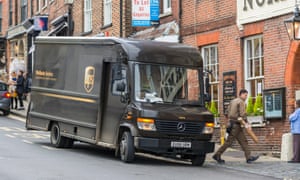
To cities, delivery vans present problems when they are moving and when they are still. In Britain, the number of miles travelled by these vans has increased by 56% since 2000, according to a report by the Society of Motor Manufacturers and Traders. (For comparison, the rise in passenger car miles is 9%.) The consequent traffic is so grave that, last year, councils in England and Wales demanded that the government disburse 1bn a year to them so they could repair roads and tackle congestion. In trying to dodge traffic and order our stuff online, we have only succeeded in making traffic worse.
The severe haste with which deliveries must be completed has even proven fatal. Amazon has its own network of 800 courier companies, and in at least 100 US lawsuits, Amazon has been named as a defendant because of deaths or injuries in accidents caused by those vans, investigations by BuzzFeed and ProPublica found in August. In mid-October, Amazon fired three courier firms over their accident rate.
When the vans pull up to make their deliveries, they cause further disorder. They double-park frequently, or occupy bike lanes or no-parking zones. Mary Snyder, a parking strategist at Seattles Department of Transportation, told me that half the traffic signs the city puts up now deal with kerb rules: who can load or unload, who can park and when. Last year, the New York Times reported, four companies FedEx, UPS and the grocers FreshDirect and Peapod racked up 500,000 parking violations, up from 372,000 in 2013. But when they are given tickets, the companies simply pay them. The expense is preferable to a failed delivery, especially since several cities including New York discount their fines on delivery vans so heavily that, for example, double-parking in Manhattan earns only a $35 ticket, instead of the full $115 that other vehicles pay.
As cities try to adjust to these torrents of traffic, companies have had to contend with new rules: congestion charges, ultra-low emission zones, restricted driving times. Ten-thousand of UPSs 120,000 trucks in its global fleet now run on alternative fuels. In the loading bay in Kentish Town, Harris showed me a stack of electricity storage batteries the first in any UPS facility. The batteries are crucial, because the package centres power supply is not sufficient to charge a full fleet of electric vans. (In 2011, when UPS plugged in its 20th EV, the buildings lights went out.) Then he showed me a low, slim parcel trailer that can be loaded on to an electric quadcycle a delivery rickshaw of sorts, which UPS is currently testing in Dublin.
I brought up robots. A few months earlier, I had been walking down the street in Berkeley when I nearly barked my shin on a tiny delivery buggy called Kiwibot, made by a startup named Kiwi. The Kiwibot was shuffling along like an arthritic dog; its hutch probably held Chipotle or Jamba Juice. (Berkeleys students are always hungry but never cook, a Kiwi official told a reporter in May. Without robots, theyd eat ramen all day.) I stepped around and walked ahead, but when I looked back, the Kiwibot had stalled, as if perplexed that it did not have the pavement all to itself. Were automated delivery vehicles the future? I asked Harris.
He didnt think so. People dont want to give up the social interaction with the driver.
He did not quite convince me. We have already, with great alacrity, given up far more meaningful social interactions in our lives as consumers. Many of us do not know anything about our grocer and our butcher; we wouldnt recognise our postal clerks or our bank clerks if we sat next to them on the bus; very few people have a milkman to recognise. Online, each of us functions as a one-dimensional identity: as consumer or vendor, to consume or sell in our own bubbles, unaware of the other except as a clump of anonymised data. Even with free shipping, that is the transaction cost.
Eventually, we will want our deliveries to be so prompt that we will practically be sitting on top of the products we will order. At Chetwoods, the architecture firm, a managing director named Tim Ward told me about brownfield sites in London that the e-commerce industry can swallow: real estate that has fallen into disuse, and that can be repurposed to hold inventory and sort deliveries. Car parks, for instance, that will empty out as people drive less, and which can be converted into fulfilment centres for half-hour orders. Or multi-storey towers, each floor connected to the next by a ramp, so that vans can drive goods up and down the building. Or underground storage caverns, one of which is already being prepared near Heathrow. Other companies had mined the area for minerals, Ward explained. Why fill that void in? Why not use it for logistics? It makes an ideal use, and then you can put a lovely park across the top of it.
Ward told me about another brownfield resource in London that Chetwoods hopes, ingeniously, to renovate: a six-mile underground railway that connects Paddington in west London to Whitechapel in east London. The Royal Mail built and used it, from 1927 to 2003, to convey up to 4m letters daily.Why not pull it back into use as a parcel delivery network, Ward said.
The tunnel passes under some of Londons busiest districts: Oxford Street, the West End, the City. The Royal Mail had sunk nine vertical shafts into it, through which packages can be sent above ground. For 498m, Chetwoods estimates, it can turn the line into a chute for 16,000 deliveries per hour, erasing a quarter of daily city traffic in the process. Selfridges is interested, a Chetwoods pitch deck told me; so are John Lewis, DHL and Amazon.
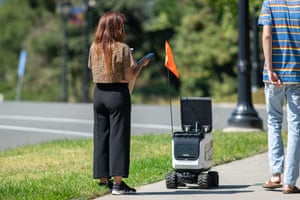
A popular trope about Silicon Valley involves its skill of regurgitation. Its companies vie to replace public services or brick-and-mortar businesses, after deeming these business models inefficient. Then they dress up those same models and spit them back out as their own revenue plans. In 2017, Lyft rolled out Shuttle, where commuters wait at designated locations to share rides: a bus service. MakeSpace raised millions of dollars for its product: Cloud storage for physical stuff or storage lockers. Apples human curators of news are editors. WeLives co-living spaces are hostels and dorms. Uber Health is the ambulance.
At first glance, the Well-line, as Chetwoods calls it,feels like an example of this an asset funded by taxpayers, built by a public utility that has itself been privatised. And we might say the same about other new wrinkles in e-commerce. The mixed-use Shed of the Future, as described to me by the architect James Nicholls, would incorporate housing, retail, transport and logistics. Beds and sheds, he said, like the model villages of the 19th century. Several logistics executives told me that if half-full freight vans from multiple firms kept congesting the streets, the best solution might be for every retailer to use a single firm instead. One delivery service to rule them all just like the postal service of yore. The lockers now offered by numerous startups as well as by Amazon and UPS born out of the frustration of failed deliveries to shoppers who arent home resemble regular PO boxes. The alternative to lockers is to deposit parcels for pick-up at a convenient point near the house: a greengrocers or a cafe or a bodega. It put me in mind of a business plan: a neighbourhood outlet that exists to hold deliveries that customers can collect for a small fee, and that stocks some bare essentials besides. Milk, perhaps, and eggs and bread, and some stationery and detergent. A general store in all but name.
But it would be a mistake to imagine that we are benignly coming full circle, or even that we are finding that the old ways are still the most efficient. A tectonic shift has occurred. A ride-hailing companys bus system urges us to forget that we ought to expect public transport from our governments. Similarly, the effortlessness of home delivery urges us to forget that, once upon a time, we were a part of the supply chain, lugging our goods home in plastic bags or loading up our cars. We were our own last-mile solution. When we quit that role, it was as if the supply chain became invisible to us.
Which is why we are not taking any notice that the apparatus of buying will soon be everywhere in our lives. It is already under our thumbs in our apps, and in most delivery vans in most streets. Soon it will be in our fridges, washing machines and printers, ordering refills; it will be beneath our feet in storage canyons and delivery tunnels; it will tower above us in multi-storey city blocks. Under our beds, we will have sheds. One Amazon idea is to allow couriers inside our houses to drop packages off when we arent in; another is to let them open the trunks of our parked cars to leave our parcels in there; a third is a personal gopher: a buggy in every home trundles out to a van, picks up our orders, and brings them in. We come home from work, and there our gifts are, as if magicked into being. The final triumph of home delivery will be when we forget that anything is being delivered at all.
Follow the Long Read on Twitter at @gdnlongread, and sign up to the long read weekly email here.
Read more: https://www.theguardian.com/technology/2019/nov/21/how-our-home-delivery-habit-reshaped-the-world


Recent Comments